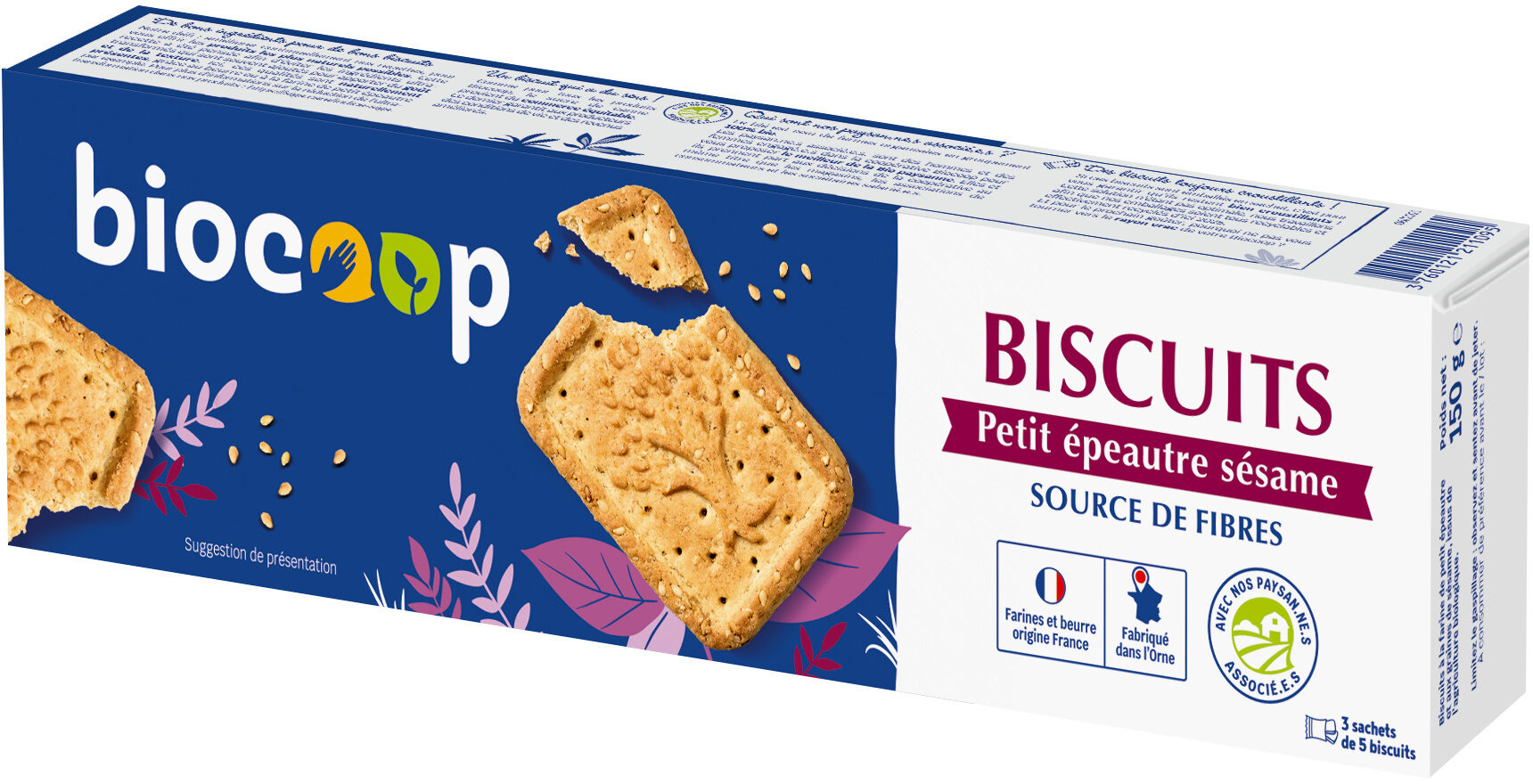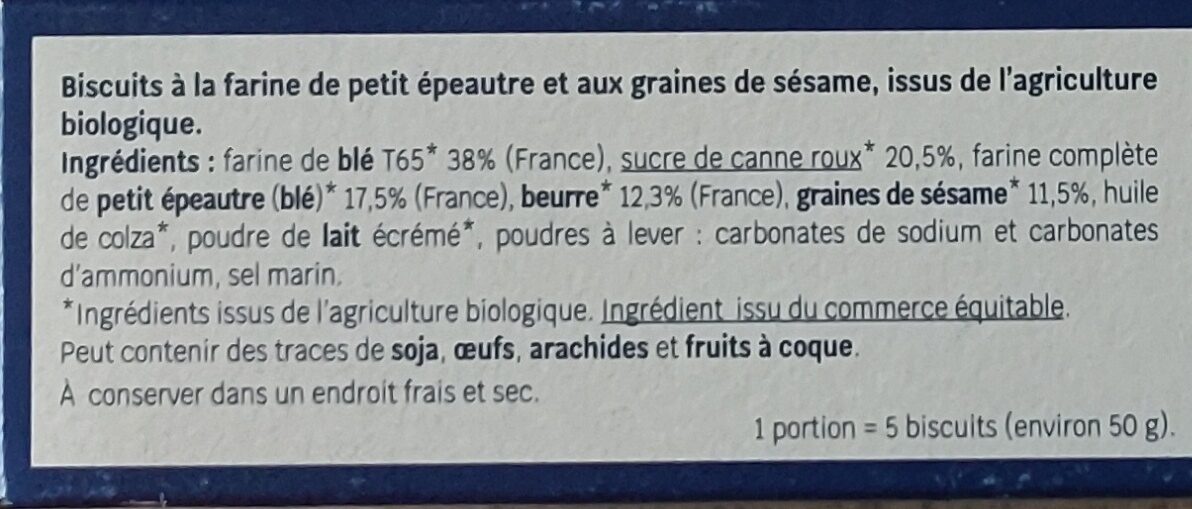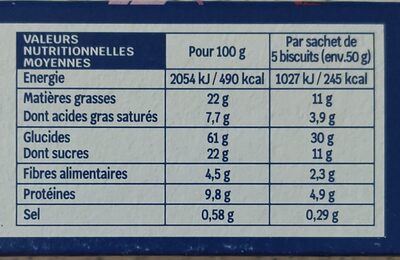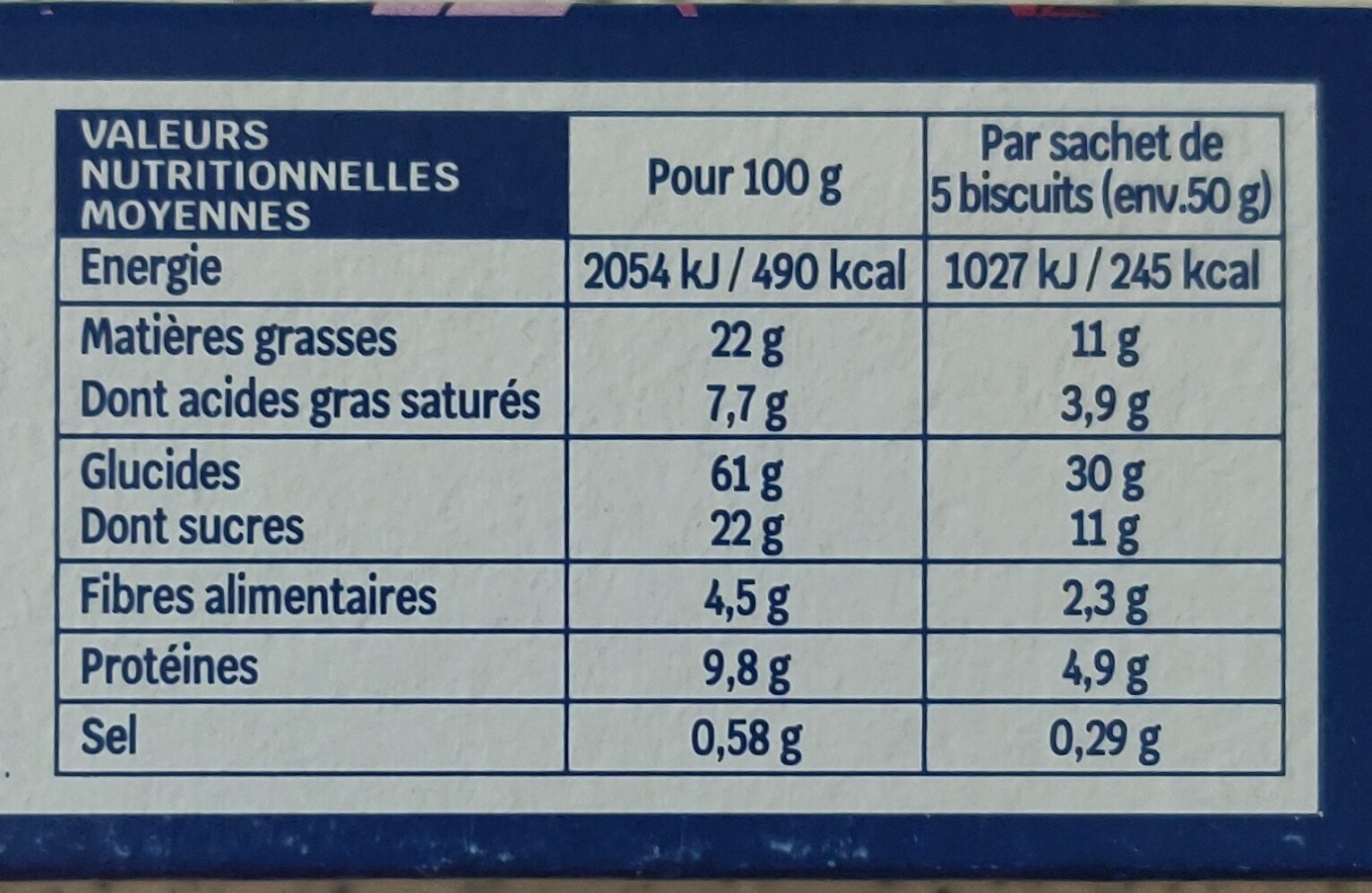Help us make food transparency the norm!
As a non-profit organization, we depend on your donations to continue informing consumers around the world about what they eat.
The food revolution starts with you!
Biscuits petit épeautre sésame - Biocoop - 150 g
Biscuits petit épeautre sésame - Biocoop - 150 g
Some of the data for this product has been provided directly by the manufacturer Biocoop.
Barcode: 3760121211095 (EAN / EAN-13)
Common name: Biscuits à la farine de petit épeautre et aux graines de sésame issus de l'agriculture biologique
Quantity: 150 g
Packaging: Plastic, Bag, Cardboard, Sleeve, fr:Etui en carton
Brands: Biocoop
Categories: Snacks, Sweet snacks, Biscuits and cakes, Biscuits, Dry biscuits
Labels, certifications, awards:
Fair trade, Organic, EU Organic, Non-EU Agriculture, Source of fibre, EU Agriculture, EU/non-EU Agriculture, FR-BIO-01, Green Dot, High fibres, Made in France, AB Agriculture Biologique, Triman, fr:Avec nos paysan.ne.s associé.e.s, fr:Je suis solidaire



Origin of ingredients: fr:Beurre - petit épeautre - blé : France, fr:Sésame : Afrique & Amérique latine
Manufacturing or processing places: France, Lonlay l'Abbaye, Biscuiterie de l'Abbaye
Stores: Biocoop
Countries where sold: France, Switzerland
Matching with your preferences
Health
Ingredients
-
13 ingredients
French: Farine de blé T65* 38% (France), sucre de canne roux* 20.5%, farine de petit épeautre (blé)* 17.5% (France), beurre* 12,3% (France), graines de sésame* 11.5%, huile de colza*, poudre de lait écrémé*, poudres à lever : carbonates de sodium et carbonates d'ammonium, sel marin. *Ingrédients issus de l'Agriculture Biologique Ingrédient issu du commerce équitableAllergens: Gluten, Milk, Sesame seedsTraces: Eggs, Nuts, Peanuts, Soybeans, fr:cacahuetes-et-produits-en-contenant, fr:fruits-a-coques-noix, fr:noix-de-macadamia-et-produits-en-contenant, fr:soja-et-produits-en-contenant, fr:oeufs-et-produits-en-contenant
Food processing
-
Processed foods
Elements that indicate the product is in the 3 - Processed foods group:
- Ingredient: Butter
- Ingredient: Salt
- Ingredient: Sugar
- Category: Sweet snacks
- Ingredient: Milk powder
Food products are classified into 4 groups according to their degree of processing:
- Unprocessed or minimally processed foods
- Processed culinary ingredients
- Processed foods
- Ultra processed foods
The determination of the group is based on the category of the product and on the ingredients it contains.
Additives
-
E500 - Sodium carbonates
Sodium carbonates (E500) are compounds commonly used in food preparation as leavening agents, helping baked goods rise by releasing carbon dioxide when they interact with acids.
Often found in baking soda, they regulate the pH of food, preventing it from becoming too acidic or too alkaline. In the culinary world, sodium carbonates can also enhance the texture and structure of foods, such as noodles, by modifying the gluten network.
Generally recognized as safe, sodium carbonates are non-toxic when consumed in typical amounts found in food.
-
E503 - Ammonium carbonates
Ammonium carbonate: Ammonium carbonate is a salt with the chemical formula -NH4-2CO3. Since it readily degrades to gaseous ammonia and carbon dioxide upon heating, it is used as a leavening agent and also as smelling salt. It is also known as baker's ammonia and was a predecessor to the more modern leavening agents baking soda and baking powder. It is a component of what was formerly known as sal volatile and salt of hartshorn.Source: Wikipedia
Ingredients analysis
-
Palm oil free
No ingredients containing palm oil detected
Unrecognized ingredients: fr:bioSome ingredients could not be recognized.
We need your help!
You can help us recognize more ingredients and better analyze the list of ingredients for this product and others:
- Edit this product page to correct spelling mistakes in the ingredients list, and/or to remove ingredients in other languages and sentences that are not related to the ingredients.
- Add new entries, synonyms or translations to our multilingual lists of ingredients, ingredient processing methods, and labels.
If you would like to help, join the #ingredients channel on our Slack discussion space and/or learn about ingredients analysis on our wiki. Thank you!
-
Non-vegan
Non-vegan ingredients: Butter, Skimmed milk powderSome ingredients could not be recognized.
We need your help!
You can help us recognize more ingredients and better analyze the list of ingredients for this product and others:
- Edit this product page to correct spelling mistakes in the ingredients list, and/or to remove ingredients in other languages and sentences that are not related to the ingredients.
- Add new entries, synonyms or translations to our multilingual lists of ingredients, ingredient processing methods, and labels.
If you would like to help, join the #ingredients channel on our Slack discussion space and/or learn about ingredients analysis on our wiki. Thank you!
-
Vegetarian status unknown
Unrecognized ingredients: fr:bioSome ingredients could not be recognized.
We need your help!
You can help us recognize more ingredients and better analyze the list of ingredients for this product and others:
- Edit this product page to correct spelling mistakes in the ingredients list, and/or to remove ingredients in other languages and sentences that are not related to the ingredients.
- Add new entries, synonyms or translations to our multilingual lists of ingredients, ingredient processing methods, and labels.
If you would like to help, join the #ingredients channel on our Slack discussion space and/or learn about ingredients analysis on our wiki. Thank you!
-
Details of the analysis of the ingredients
We need your help!
Some ingredients could not be recognized.
We need your help!
You can help us recognize more ingredients and better analyze the list of ingredients for this product and others:
- Edit this product page to correct spelling mistakes in the ingredients list, and/or to remove ingredients in other languages and sentences that are not related to the ingredients.
- Add new entries, synonyms or translations to our multilingual lists of ingredients, ingredient processing methods, and labels.
If you would like to help, join the #ingredients channel on our Slack discussion space and/or learn about ingredients analysis on our wiki. Thank you!
fr: Farine de blé T65 38%, sucre de canne roux 20.5%, farine de petit épeautre (blé), Bio 17.5%, beurre 12.3%, graines de sésame 11.5%, huile de colza, poudre de lait écrémé, poudres à lever (carbonates de sodium, carbonates d'ammonium), sel marin- Farine de blé T65 -> fr:farine-de-ble-type-65 - labels: en:organic - vegan: yes - vegetarian: yes - ciqual_proxy_food_code: 9410 - percent: 38
- sucre de canne roux -> en:unrefined-cane-sugar - labels: en:organic - vegan: yes - vegetarian: yes - ciqual_proxy_food_code: 31016 - percent: 20.5
- farine de petit épeautre -> en:einkorn-flour - vegan: yes - vegetarian: yes - ciqual_proxy_food_code: 9410
- blé -> en:wheat - vegan: yes - vegetarian: yes - ciqual_proxy_food_code: 9410
- Bio -> fr:bio - labels: en:organic, en:organic - percent: 17.5
- beurre -> en:butter - labels: en:organic - vegan: no - vegetarian: yes - ciqual_proxy_food_code: 16400 - percent: 12.3
- graines de sésame -> en:sesame-seeds - labels: en:organic - vegan: yes - vegetarian: yes - ciqual_food_code: 15010 - percent: 11.5
- huile de colza -> en:colza-oil - labels: en:organic - vegan: yes - vegetarian: yes - from_palm_oil: no - ciqual_food_code: 17130
- poudre de lait écrémé -> en:skimmed-milk-powder - labels: en:organic - vegan: no - vegetarian: yes - ciqual_food_code: 19054
- poudres à lever -> en:raising-agent
- carbonates de sodium -> en:e500 - vegan: yes - vegetarian: yes
- carbonates d'ammonium -> en:e503 - vegan: yes - vegetarian: yes
- sel marin -> en:sea-salt - vegan: yes - vegetarian: yes - ciqual_food_code: 11082
Nutrition
-
Poor nutritional quality
This product is not considered a beverage for the calculation of the Nutri-Score.
Positive points: 4
- Proteins: 5 / 5 (value: 9.8, rounded value: 9.8)
- Fiber: 4 / 5 (value: 4.5, rounded value: 4.5)
- Fruits, vegetables, nuts, and colza/walnut/olive oils: 0 / 5 (value: 0, rounded value: 0)
Negative points: 19
- Energy: 6 / 10 (value: 2058, rounded value: 2058)
- Sugars: 4 / 10 (value: 22, rounded value: 22)
- Saturated fat: 7 / 10 (value: 7.7, rounded value: 7.7)
- Sodium: 2 / 10 (value: 232, rounded value: 232)
The points for proteins are not counted because the negative points are greater or equal to 11.
Nutritional score: (19 - 4)
Nutri-Score:
-
Nutrient levels
-
Fat in high quantity (22%)
What you need to know- A high consumption of fat, especially saturated fats, can raise cholesterol, which increases the risk of heart diseases.
Recommendation: Limit the consumption of fat and saturated fat- Choose products with lower fat and saturated fat content.
-
Saturated fat in high quantity (7.7%)
What you need to know- A high consumption of fat, especially saturated fats, can raise cholesterol, which increases the risk of heart diseases.
Recommendation: Limit the consumption of fat and saturated fat- Choose products with lower fat and saturated fat content.
-
Sugars in high quantity (22%)
What you need to know- A high consumption of sugar can cause weight gain and tooth decay. It also augments the risk of type 2 diabetes and cardio-vascular diseases.
Recommendation: Limit the consumption of sugar and sugary drinks- Sugary drinks (such as sodas, fruit beverages, and fruit juices and nectars) should be limited as much as possible (no more than 1 glass a day).
- Choose products with lower sugar content and reduce the consumption of products with added sugars.
-
Salt in moderate quantity (0.58%)
What you need to know- A high consumption of salt (or sodium) can cause raised blood pressure, which can increase the risk of heart disease and stroke.
- Many people who have high blood pressure do not know it, as there are often no symptoms.
- Most people consume too much salt (on average 9 to 12 grams per day), around twice the recommended maximum level of intake.
Recommendation: Limit the consumption of salt and salted food- Reduce the quantity of salt used when cooking, and don't salt again at the table.
- Limit the consumption of salty snacks and choose products with lower salt content.
-
-
Nutrition facts
Nutrition facts As sold
for 100 g / 100 mlAs sold
per serving (50 g, 5 biscuits)Compared to: Dry biscuits Energy 2,058 kj
(490 kcal)1,030 kj
(245 kcal)+11% Fat 22 g 11 g +42% Saturated fat 7.7 g 3.85 g +45% Carbohydrates 61 g 30.5 g -8% Sugars 22 g 11 g -22% Fiber 4.5 g 2.25 g +38% Proteins 9.8 g 4.9 g +28% Salt 0.58 g 0.29 g +19% Fruits‚ vegetables‚ nuts and rapeseed‚ walnut and olive oils 0 % 0 % -100% Fruits‚ vegetables‚ nuts and rapeseed‚ walnut and olive oils (estimate from ingredients list analysis) 0 % 0 %
Environment
-
Eco-Score B - Low environmental impact
⚠ ️Select a country in order to include the full impact of transportation.The Eco-Score is an experimental score that summarizes the environmental impacts of food products.→ The Eco-Score was initially developped for France and it is being extended to other European countries. The Eco-Score formula is subject to change as it is regularly improved to make it more precise and better suited to each country.Life cycle analysis
-
Average impact of products of the same category: B (Score: 69/100)
Category: Biscuit (cookie)
Category: Biscuit (cookie)
- PEF environmental score: 0.35 (the lower the score, the lower the impact)
- including impact on climate change: 2.88 kg CO2 eq/kg of product
Stage Impact Agriculture
80.5 %Processing
11.8 %Packaging
3.1 %Transportation
3.2 %Distribution
1.4 %Consumption
0.0 %
Bonuses and maluses
-
Labels with high environmental benefits
Bonus: +15
-
AB Agriculture Biologique
Organic agriculture contributes to preserve biodiversity, climate, water quality and soil fertility.
Organic food is food produced by methods complying with the standards of organic farming and features practices that cycle resources, promote ecological balance, and conserve biodiversity.
-
EU Organic
Organic agriculture contributes to preserve biodiversity, climate, water quality and soil fertility.
Organic food is food produced by methods complying with the standards of organic farming and features practices that cycle resources, promote ecological balance, and conserve biodiversity.
-
-
Origins of ingredients with a high impact
Malus: 0
Environmental policy: 0
Transportation: 0
Origin of the product and/or its ingredients % of ingredients Impact France 59 %Medium Unknown 41 %High
-
Packaging with a medium impact
Malus: -11
Shape Material Recycling Impact Bag Plastic Discard High Sleeve Cardboard Recycle Low
Eco-Score for this product
-
Impact for this product: B (Score: 73/100)
Product: Biscuits petit épeautre sésame - Biocoop - 150 g
Life cycle analysis score: 69
Sum of bonuses and maluses: +4
Final score: 73/100
-
Carbon footprint
-
Equal to driving 1.5 km in a petrol car
288 g CO² per 100g of product
The carbon emission figure comes from ADEME's Agribalyse database, for the category: Biscuit (cookie) (Source: ADEME Agribalyse Database)
Stage Impact Agriculture
82.9 %Processing
7.9 %Packaging
3.8 %Transportation
4.7 %Distribution
0.7 %Consumption
0.0 %
Packaging
-
Packaging with a medium impact
-
Packaging parts
Sleeve (Cardboard)
Bag (Plastic)
-
Packaging materials
Material % Packaging weight Packaging weight per 100 g of product Paper or cardboard Plastic Total
-
Transportation
-
Origins of ingredients
Origins of ingredients with a high impact
Origin of the product and/or its ingredients % of ingredients Impact France 59 %Medium Unknown 41 %High
Labels
-
AB Agriculture Biologique
Organic agriculture contributes to preserve biodiversity, climate, water quality and soil fertility.
Organic food is food produced by methods complying with the standards of organic farming and features practices that cycle resources, promote ecological balance, and conserve biodiversity.
-
EU Organic
Organic agriculture contributes to preserve biodiversity, climate, water quality and soil fertility.
Organic food is food produced by methods complying with the standards of organic farming and features practices that cycle resources, promote ecological balance, and conserve biodiversity.
Report a problem
-
Incomplete or incorrect information?
Category, labels, ingredients, allergens, nutritional information, photos etc.
If the information does not match the information on the packaging, please complete or correct it. Open Food Facts is a collaborative database, and every contribution is useful for all.
Data sources
Product added on by doc75
Last edit of product page on by org-biocoop.
Product page also edited by aleene, desan, foodrepo, julie-yuka, kiliweb, manoncorneille, openfoodfacts-contributors, packbot, quechoisir, quentinbrd, robin-chubret, roboto-app, segundo, syleg35, teolemon, youplaboum.
Last check of product page on by aleene.














